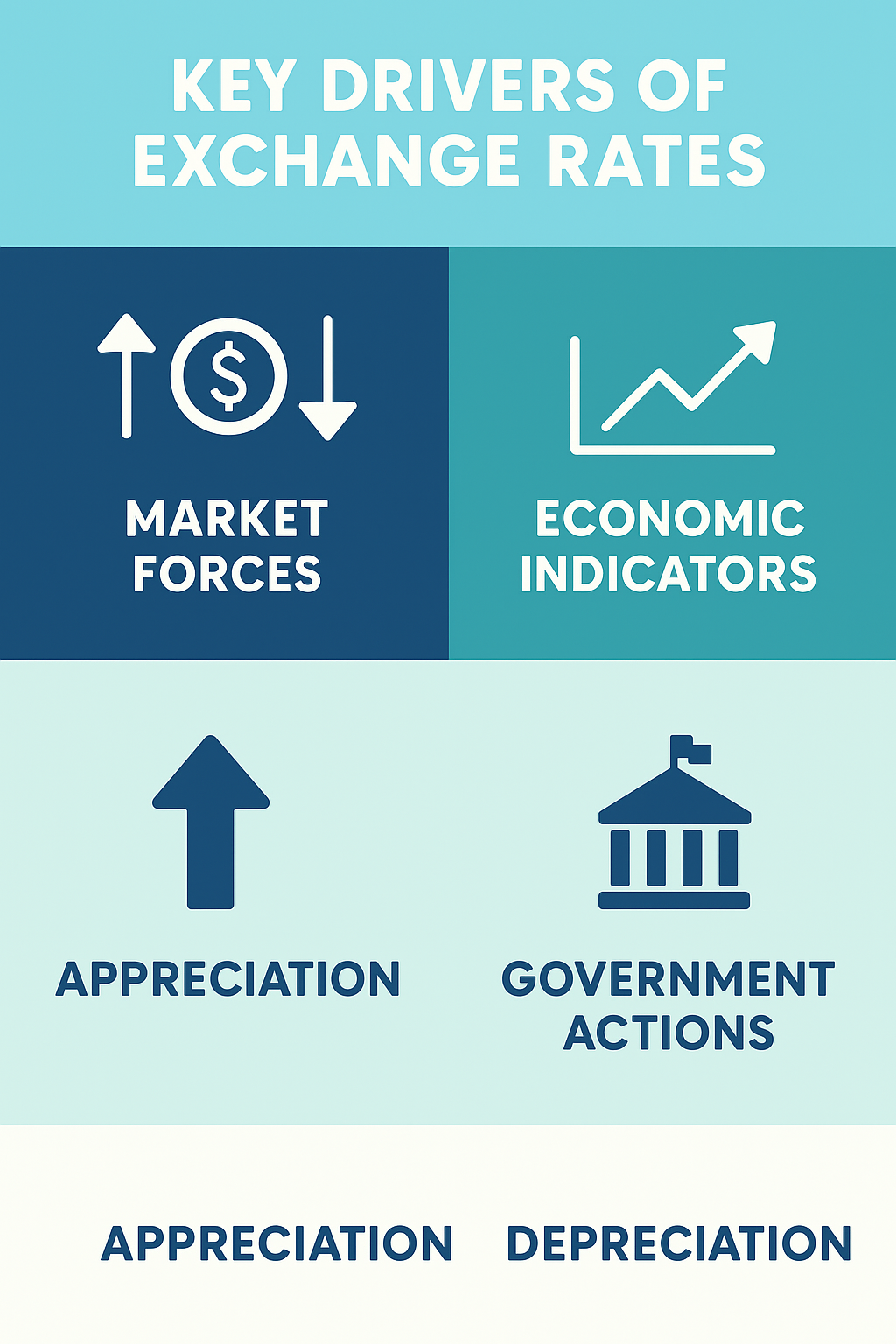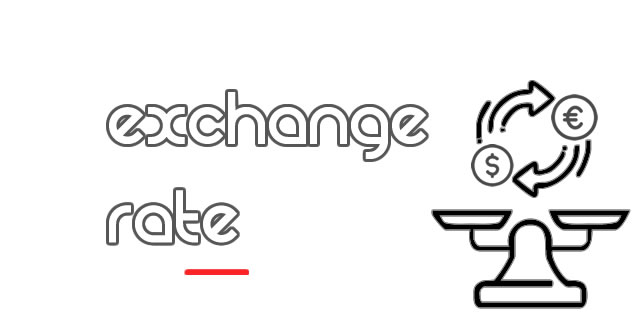Exchange rates — the price of one currency in terms of another — shape the global economy by affecting trade, investments, inflation, and living standards. But what makes a currency gain or lose value? Let’s explore the main forces behind exchange rate movements.
1. Supply and Demand: The Currency Marketplace
Think of currencies as products in a vast international marketplace. When demand for a currency increases, its value rises. When demand falls, so does its price.
- Trade Balances: A country exporting more than it imports creates demand for its currency. For example, China’s long-standing trade surplus has helped maintain demand for the yuan. Conversely, countries with trade deficits, like the U.S. in some years, often see downward pressure on the dollar.
- Foreign Investment: When foreign investors buy local stocks, real estate, or government bonds, they need the local currency, boosting its value. For example, massive foreign investment inflows into India’s stock market tend to strengthen the rupee.
- Market Speculation: Traders anticipating a currency’s rise buy it in advance, creating a self-fulfilling prophecy. Remember the Swiss Franc surge in 2015 when the Swiss National Bank unexpectedly removed its currency peg? Speculators rushed in, causing dramatic price swings.
Engagement: Have you noticed how political news or economic reports trigger sudden shifts in currency values? What impact has this had on your business or travel plans?
2. Interest Rates and Inflation: The Power Couple of Currency Strength
Interest Rates: Higher interest rates attract investors seeking better returns. For instance, when the U.S. Federal Reserve hikes rates, the dollar often strengthens as global investors shift capital into U.S. assets.
Inflation: High inflation erodes a currency’s purchasing power, reducing its attractiveness. Venezuela’s hyperinflation in recent years has decimated the bolívar’s value, forcing many to rely on USD for daily transactions.
3. Economic Performance and Confidence
Strong economies inspire investor confidence. For example, Germany’s robust GDP growth and political stability support the euro’s strength in global markets. Conversely, political instability or recession can trigger capital flight, as seen in Turkey’s lira decline during political turmoil.
4. Government and Central Bank Actions: Steering the Ship
- Monetary Policy: Central banks control interest rates to influence currency values. Japan’s long-standing low interest rates have kept the yen relatively weaker, helping exporters.
- Currency Intervention: The Swiss National Bank has repeatedly intervened to prevent the franc from becoming too strong and hurting exports.
- Capital Controls: China limits money flows to stabilize the yuan and protect its economy.
Example: In 2011, the Swiss National Bank set a minimum exchange rate of 1.20 CHF per euro to curb franc appreciation, intervening heavily until abandoning it in 2015, which led to a sharp franc spike.
Deeper Theories Behind Exchange Rate Movements
Understanding the why behind currency value shifts requires some economic theory:
Purchasing Power Parity (PPP)
PPP suggests that in the long run, exchange rates adjust so that a basket of goods costs the same across countries.
Formula:
E = Pdomestic / Pforeign
Where E is the exchange rate, Pdomestic is the domestic price level, and Pforeign is the foreign price level.
Example: If a basket costs $100 in the US and £80 in the UK, the PPP exchange rate should be 1.25 USD/GBP.
However, PPP often fails to hold short-term due to transportation costs, tariffs, and market imperfections.
Balassa-Samuelson Effect
This theory explains why richer countries tend to have higher price levels and stronger currencies. Productivity gains in tradable goods sectors raise wages, increasing prices in non-tradable sectors, pushing overall prices (and thus currencies) up.
Implication: Emerging economies often have undervalued currencies compared to developed nations because their productivity growth in tradables lags.
International Fisher Effect (IFE)
The IFE posits that differences in nominal interest rates between countries predict exchange rate changes, accounting for expected inflation.
Formula:
F / S = (1 + idomestic) / (1 + iforeign)
Where:
- F = forward exchange rate
- S = spot exchange rate
- idomestic, iforeign = interest rates
Example: If the US interest rate is 2% and the Eurozone is 1%, the dollar should depreciate against the euro by about 1% over the period.
Currency Depreciation vs. Exchange Rate Movements
Currency Depreciation: A decline in currency value relative to others (e.g., USD weakening against EUR).
Exchange Rate Movements: General fluctuations, including appreciation or depreciation.
How Can Countries Increase Their Currency’s Value?
- Tightening Monetary Policy: Raising interest rates to attract capital.
- Reducing Inflation: Maintaining price stability enhances currency appeal.
- Attracting Foreign Investment: Economic reforms and political stability encourage inflows.
- Currency Market Interventions: Central banks buying their own currency.
Can Exchange Rates Be Manipulated?
Short-term manipulation via market intervention is common but usually temporary unless backed by strong fundamentals. For example, China’s managed float system attempts to stabilize the yuan but still allows gradual market influence.
Infographic — How Currencies Gain/Lose value

Conclusion:
Exchange rates are shaped by a complex interplay of market forces, economic fundamentals, government policies, and investor psychology. Understanding these elements — from supply and demand to advanced economic theories — can help you anticipate shifts and make informed decisions.
Other Posts
- The New Gold Coin for Ghana (GGC): Value, Benefits, and How to Buy
- How to Pay Less Tax in Ghana: Smart Income Tax Planning Strategies for 2025 and beyond
- How to Reduce Your Taxable Income in Canada: 2025 Legal Tax Hacks
- Slash Your IRS Bill: 10 Legal U.S. Tax Reduction Strategies for 2025
- Pension Benefits in Ghana: How to Maximize Your Retirement Contributions
- How to Reduce Your UK Income Tax Bill: 10 Smart Legal Strategies
- Making the Numbers Work for You: Essential Financial Insights Every Business Leader Must Know
- US Tightens Chip Export Rules to China: What It Means for Global Chipmakers
- Exchange Rates: How Currencies Gain or Lose Value
- Training for Speed: Expert Tips to Improve Your Sprinting Performance
- SMART Fitness Goals: The Key to Staying Motivated and Reaching Your Fitness Potential
- Fitness Tracking Devices: Do You Really Need a Smartwatch?
- Enhance Your Training with Wearable Fitness Tech: Track, Improve, Achieve
- Why Recovery Matters: Understanding the Role of Rest Days for Fitness Progress
- Fitness Strategies: How to Build Lean Muscle Effectively
- Maximize Your Workout Results: Top Foods to Eat Before and After Exercise
- Real Estate Crowdfunding: A Low-Cost Way to Invest in Real Estate
- Real Estate Investing Strategies: How to Flip Houses & Build Passive Rental Income
- Mobile Payments: The Future of Fast and Secure Transactions
- AI in Finance: How Artificial Intelligence is Revolutionizing Financial Services
- The Future of Insurance: How InsurTech is Disrupting Traditional Models
- Understanding Your Financial Behavior: The Psychology of Money & How to Manage It
- Breaking Free from Debt: Proven Strategies to Achieve Financial Freedom
- The Hidden Dangers of IoT: How to Safeguard Your Connected Devices
- IoT and Agriculture: Feeding the World with Technology
- AI Investing: Best AI Stocks to Improve your portfolio
- AI Creativity : Can Machines Truly Innovate
- IoT For Business Efficiency: Key Benefits and Applications
- Cybersecurity Threats: How to Defend Against Digital Attacks
